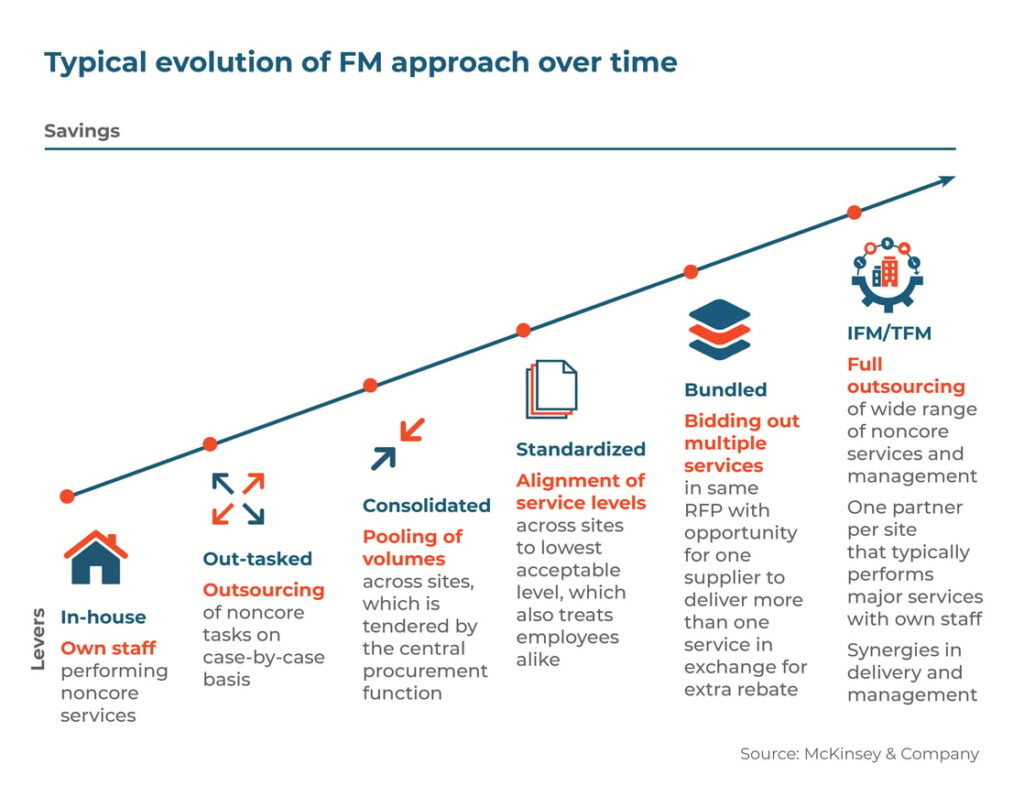Top Advantages of Total Facility Management for Streamlined Workflow
Total Facility Management (TFM) stands for a critical method to improving functional performance by incorporating various solutions, such as upkeep and security, under a unified management structure. The question continues to be: what details benefits can companies harness from embracing TFM, and just how might these advantages change their functional landscape?
Boosted Operational Efficiency
Improved operational performance is a main advantage of applying total facility management (TFM) strategies. TFM includes a comprehensive strategy to taking care of a facility's resources, procedures, and framework, eventually improving operations. By consolidating numerous services-- such as upkeep, safety and security, cleaning, and room management-- TFM reduces redundancies and boosts control among various operational functions.
The assimilation of technology more amplifies this effectiveness. Advanced facility management systems supply real-time data analytics, allowing facility managers to make educated choices that improve operations and source appropriation. Anticipating maintenance techniques, for instance, expect devices failings prior to they take place, lowering downtime and expanding possession life expectancy.
In addition, TFM promotes standardized procedures across various departments, ensuring uniformity and high quality in solution shipment. This uniformity minimizes functional disturbances and cultivates an extra collaborative workplace. Consequently, staff members can concentrate on their core obligations, driving efficiency and boosting total efficiency.

Expense Reduction and Savings
Implementing total facility management (TFM) not just increases operational performance yet also significantly adds to set you back reduction and cost savings. By combining different services under a solitary management structure, organizations can get rid of redundancies and improve procedures, thus minimizing functional costs. TFM allows far better purchase strategies, enabling firms to negotiate bulk investing in contracts with vendors and provider, leading to reduced costs.
Additionally, TFM stresses preventive upkeep, which minimizes unforeseen malfunctions and expands the lifespan of important tools. This aggressive strategy not just lowers repair costs but likewise improves the dependability of facilitiess, making certain uninterrupted operations. Furthermore, power efficiency campaigns, frequently a vital focus of TFM, cause considerable cost savings on energy costs, as facilitiess are enhanced for lowered power usage.
Improved Source Management
Reliable resource management is a foundation of total facility management (TFM), making it possible for organizations to maximize the use of their possessions and workforce. By carrying out TFM strategies, organizations can adequately evaluate their source appropriation, making sure that every possession is utilized effectively and properly. This holistic approach permits the recognition of underperforming sources and the capacity for reallocation or enhancement.
Additionally, TFM facilitates the assimilation of technology for real-time tracking of resources, which assists in forecasting maintenance needs and protecting against costly downtime. By leveraging information analytics, organizations can make educated decisions about resource implementation, ultimately boosting efficiency and reducing waste.
Furthermore, TFM advertises a culture of continual improvement, urging groups to on a regular basis review and fine-tune their source management practices. Total Facility Management. This proactive stance not just decreases functional interruptions yet also fosters technology, as employees are equipped to recommend renovations based on their direct experiences with source utilization
Streamlined Interaction Channels
In total facility management, structured communication networks play an essential function in promoting collaboration and efficiency across teams. Effective interaction makes certain that all stakeholders, consisting of facility supervisors, upkeep team, and service suppliers, are aligned with operational requirements and organizational goals. By developing clear lines of communication, groups can swiftly resolve problems, share updates, and execute options, therefore reducing downtime and boosting productivity.
With systematized communication systems, info is conveniently accessible, enabling for real-time updates on maintenance requests, source allowance, and job timelines. This openness not only decreases misunderstandings but likewise equips employees to make informed choices quickly. Streamlined communication assists in much better coordination throughout emergencies, ensuring that all employees are notified and can respond promptly.

Increased Emphasis on Core Activities
A vital benefit of total facility management go to this site is the enhanced focus on core activities, enabling organizations to concentrate on their primary business objectives - Total Facility Management. By contracting out non-core features such as cleansing, protection, and upkeep, firms can reroute their sources and power in the direction of tactical efforts that straight add to their affordable benefit and development
Total facility management incorporates numerous functional jobs under a single umbrella, promoting efficiency and decreasing redundancy. This combination not only simplifies procedures but also improves accountability, making certain that every aspect of the facility runs sympathetically without drawing away attention from what absolutely matters-- core business features.
Additionally, this strategy enables workers to commit their effort and time to tasks that drive advancement and boost customer contentment, as opposed to getting slowed down by functional obstacles. With a trustworthy facility management companion dealing with everyday operations, organizations can achieve better dexterity, respond quickly to market adjustments, and maintain a sharper concentrate on their mission.
Ultimately, boosted concentrate on core tasks causes boosted total performance, permitting companies to reinforce their market position and fulfill their tactical goals better. - Total Facility Management
Final Thought
In final thought, Total Facility Management dramatically enhances functional efficiency by settling vital services and leveraging information analytics for educated decision-making. Price decreases and enhanced source management add to general cost savings, while streamlined interaction channels foster collaboration amongst stakeholders.
Total Facility Management (TFM) stands for a strategic approach to boosting operational performance by incorporating numerous services, such as maintenance and protection, under a unified management framework.Boosted functional effectiveness is a main advantage of implementing total facility management (TFM) techniques. Advanced facility management systems offer real-time data analytics, allowing facility supervisors to make informed decisions that enhance workflow and resource appropriation.Executing total facility management (TFM) not just improves functional effectiveness but additionally considerably contributes to set you Read Full Report back reduction and financial savings.Efficient resource management is a foundation of total facility management (TFM), allowing companies to maximize the use of their properties and workforce.